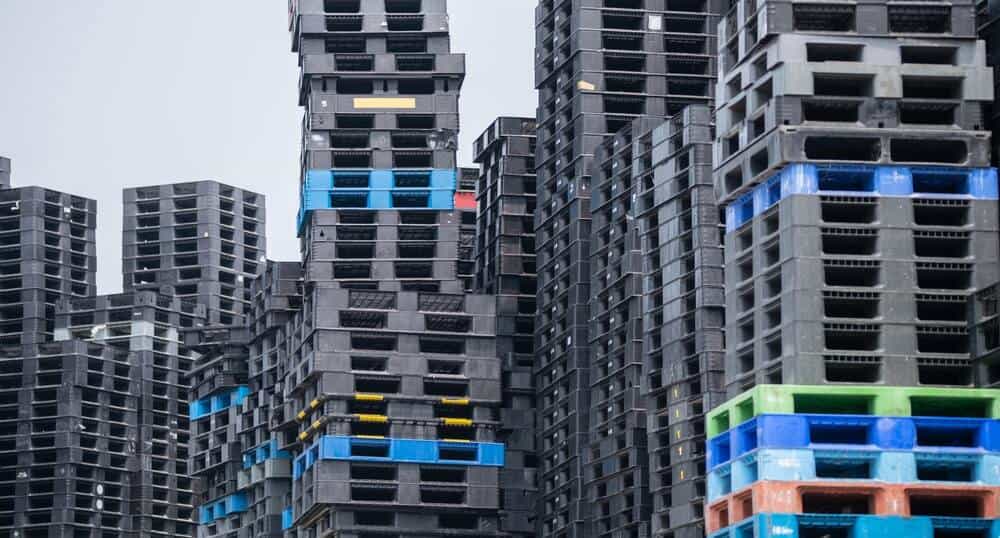Proper pallet stacking methods can effectively manage warehouse stock, streamline the movement of goods, ensure safety, and maximise space usage. This article provides the answers for entrepreneurs seeking solutions for efficient pallet stacking systems.

The Importance of Pallet Stacking
Efficient pallet stacking is crucial for business operations. One widely adopted method is using pallets for stacking and transporting goods. Pallets, made from various materials like wood, plastic, or metal, are designed to support the weight of goods and facilitate movement using equipment such as forklifts or hand trucks.
Utilising pallets for stacking goods not only meets industry standards but also brings numerous benefits that directly impact operational efficiency, costs, and warehouse management quality. The importance of pallet stacking can be summarised as follows:
1. Enhancing Transport Efficiency
Using pallets makes moving large quantities of goods with equipment like forklifts or pallet trucks, easier and quicker. This saves time and labour in handling goods and allows for orderly and efficient stacking in trucks or containers.
2. Increasing Storage Space
Pallet stacking allows for higher vertical stacking, optimising vertical space usage. This enables more goods to be stored in the same area, reducing the need for additional warehouse space and lowering associated costs.
3. Protecting Goods from Damage
Pallets elevate goods off the ground, protecting them from moisture and damage during handling. Proper pallet stacking also distributes weight evenly and prevents goods from crushing each other, reducing the risk of damage during storage and transport.
4. Facilitating Easy Inventory Counting
Stacking goods on pallets simplifies and speeds up inventory counting. Clearly defined units of goods on pallets make it easier to check stock levels accurately, reducing the time employees spend on inventory tasks.
5. Creating a Professional Image
Neat and orderly pallet stacking leaves a positive impression on customers and business partners. It showcases professional warehouse management that adheres to standards, which positively impacts the company’s image and credibility in business operations.
Pallet Stacking Standards
Standards for pallet stacking affect the efficiency of warehouse management and logistics processes. These standards are continuously developed and improved to meet warehouse management needs and ensure safety in operational areas, focusing on three main factors:

1. Pallet Sizes
The size of the pallet is a crucial factor in efficient stacking. Currently, there are three main standard sizes:
- Euro Pallet: Measuring 80 x 120 centimetres, this pallet adheres to GMP (Good Manufacturing Practice) and HACCP (Hazard Analysis and Critical Control Points) standards, particularly important in the food production process. Euro pallets are popular in Europe and fit well with the region’s transport and warehouse systems.
- Japan Pallet: At 110 x 110 centimetres, this size is widely used in the ASEAN region and is suitable for transport and storage systems in Southeast Asia.
- American Pallet: With dimensions of 100 x 120 centimetres, this plastic pallet is commonly used in the United States, Canada, and extensively in Thailand.
2. Pallet Materials
Pallets come in a variety of materials, each with specific usage and load-bearing characteristics:
- Wooden Pallets: Must comply with IPPC (International Plant Protection Convention) regulations to prevent the spread of pests like fungi, insects, and termites. Wooden pallets used for international shipping should always bear the IPPC mark.
- Plastic Pallets: Durable, lightweight, and easy to maintain, plastic pallets eliminate concerns about moisture and other issues found with wooden pallets. They are reusable and cost-effective.
- Metal Pallets: The most comprehensive in terms of durability and safety, metal pallets are fire-resistant and can support heavier loads than other types, making them ideal for industries handling heavy products.
3. Pallet Stacking Systems
- Column Stack: Goods are stacked in precise blocks, suitable for strong and durable items.
- Interlocking Stack: Pallets are stacked in a crisscross pattern to increase stability and reduce the risk of toppling.
- Racking System: Pallets are placed on shelving systems commonly found in large warehouses or factories. This includes both drive-in racking systems and push-back racking systems.
- Securing: Using straps or plastic wrap to secure goods on pallets, preventing movement during transport to ensure safe delivery.
How To Stack Pallets In A Warehouse
After understanding the widely used standard warehouse pallet stacking methods, let’s explore the various ways to stack goods on pallets to ensure safe delivery, preventing toppling or damage from compression:
- Row Stacking: Goods of the same size are neatly stacked in rows, providing stability. Minor securing with straps or adhesives ensures everything stays in place.
- Alternating Stacking: This method is used for solid items of varying sizes. It involves stacking in an alternating pattern to save space.
Enhance your warehouse space management with Tellus’ industrial pallet racking solutions. As a leader in storage innovation and warehouse racking in Thailand, we offer quality, standard-compliant solutions with expert after-sales support to meet your warehouse needs. For more information, call 02-643-8044
Source:
- Different pallet packing methods and palletizing patterns (charts). 23 July 2024. https://verbruggen-palletizing.com/about-us/news-blogs/different-pallet-packing-methods-and-palletizing-patterns-charts-an-overview/




